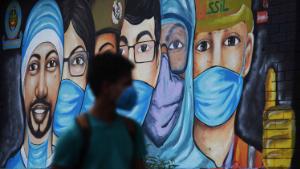
Days before India lifted its nationwide lockdown on June 1, the country’s health ministry issued a press statement with a triumphant headline. “15 countries with highest number of Covid-19 cases, with almost same population as India, have reported 34 times cases and 83 times deaths as reported in India,” it said.
Fewer than 60 days later, India has reached a million Covid-19 cases. It is now third on the Johns Hopkins University tally of country cases, following the US and Brazil. Far from flattening the curve, India’s graph of transmission is swinging skyward like a Mo Salah free kick.
Since June 1, cases per day have multiplied — from 8,100 to more than 32,000 — while total deaths surged from 5,600 to about 25,000. It has been argued that India’s count of cases per million people is relatively low and so is the fatality level, or deaths per million people.
This is true, but the case count depends on the level of testing. India’s ratio currently hovers at around 9,231 tests per million — or 9 per 1,000, compared to 128 per 1,000 in the United States.
The lower fatality rate can be partially explained by India’s younger demography, and also by gaps in the registration of deaths. According to the most recent government figures, about a fifth of all deaths in India are not registered and less than a quarter are medically certified.
The lockdown of 1.35 billion people has been the subject of competing hypotheticals. What is known is that it flattened the economy — in June, the IMF predicted that India’s GDP would contract by 4.5% in 2020, while rating agency ICRA estimated a contraction of 9.5% — and signaled the deepest recession in 60 years. The human cost, amplified by images of millions of migrants forced to return home after losing their jobs, is still unraveling.
Lockdown challenges
Lockdowns certainly enable governments to preserve order in society and, more critically, allow officials to ramp up testing tracing and treatment capacity. But there can be no doubt that India has struggled.
Maharashtra, Tamil Nadu and Delhi, three of the more prosperous states, account for more than half the case count. The repeated lockdowns in industrial hubs like Thane and Pune — not to mention the paucity of hospital beds — give an indication of what could be happening elsewhere.
The many tragedies caused by gaps in health care are symbolized by the death of 30-year-old pregnant woman Neelam Kumari Gautam after she was denied treatment in eight Delhi hospitals.
Managing the consequences of a pandemic was always going to be a challenge.
Yet what needs to be done is haunted by the magnitude of what was not done.
Vulnerability is aggravated by the comorbidity of poor governance and neglect of seven-odd decades. The Indian state struggles to provide what economist and philosopher Adam Smith defined as the most basic of obligations — water, health, education, power and security.
Investment lacking
India’s deficiency in health care was first identified in 1857, in a survey urged by an iconic sponsor, Florence Nightingale. A century and half later, India is in the company of low-income sub-Saharan countries on the Health Care Access and Quality Index — trailing neighbors Myanmar, Sri Lanka, Bhutan and Bangladesh .
Health care depends on investment in state capacity. For decades, committees and commissions have urged expenditure on health to be raised to between 4% and 6% of GDP — but it has stayed at less than 1%.
Quality of health care also depends on policies affecting life and living — of air and water. “Wash hands,” say doctors and health officials. Yet in 2019, only one in five Indian households had piped water in their homes.
Every second home depends on water from wells, unprotected water bodies or tanker water — 70% cent of water is contaminated, with India ranked 120 among 122 countries in the water quality index. Pneumonia and diarrhoea also kill more than 1.3 million children each year.
Life expectancy at birth is higher in Nepal, Bangladesh, Bhutan and Sri Lanka. Successive studies, in which government institutions have participated, shows poor air quality kills over a million every year.
Education also matters. Such is the state of government schools that millions of students have graduated in the past decade without rudimentary skills of reading and math. In 2016, Tharman Shanmugaratnam, then deputy prime minister of Singapore, invited by the government of India, told the audience of policy makers, “Schools are the biggest crisis in India today, and have been for a long time. Schools are the biggest gap between India and East Asia.”
Seventy years after its independence, India finally managed to electrify all its villages in 2019. Still, quality of supply is another matter. Barring Mumbai, no city in India can boast of 24/7 supply and households and businesses across the country must depend on inverters.
Gated republics
More and more Indians are disinvesting from hope, choosing to secede to gated republics and invest in paid-for private solutions.
Indians pay for over 60% of heath care costs from their savings — some even borrow and land in penury . More parents are also opting for private schools, with nearly 40% of students enrolled in non-public education. Water tankers, air purifiers and inverters are other ubiquitous essentials of living.
Data paints a damning picture of governance where it matters the most. India is trapped between density of population and poverty and deficit of investment.
Successive regimes have taken refuge in the diffusion of authority between federal and state governments and evaded accountability. This has been enabled by the nature of public discourse, which is riveted by emotion and rhetoric rather than reflection on realities.
Informed choices help — in combating pandemics and in improving quality of life. India’s voters need to reward attention to delivery of services and punish its neglect.
As reported by CNN
